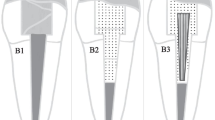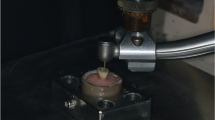Abstract
This in vitro study evaluated the effect of presence of post, presence of core, and of shape, type, and surface treatment of posts on resistance to cyclic loading of crowned human teeth. For all teeth, crowns designed without ferrule were cast in sterling silver and luted with resin cement (Panavia F). Each tooth underwent cyclic loading of 600 N at two loads per second until failure. Teeth that had only been crowned showed significantly higher resistance to cyclic loading than teeth with cores or with post and cores. No significant differences were found between teeth restored with cores only or with post and cores, irrespective of surface-treatment of the posts. Teeth restored with parallel-sided cast post (ParaPost XP) and cores showed significantly higher resistance to cyclic loading than teeth with either tapered cast posts or untreated prefabricated posts of titanium alloy (ParaPost XH) or glass fiber composite (ParaPost Fiber White). No significant difference was found between teeth restored with parallel-sided cast post and cores and teeth restored with untreated prefabricated posts of zirconia (Cerapost). Surface treatment of posts significantly increased the resistance to cyclic loading compared with untreated posts. When posts are used, surface treatment is recommended.

Similar content being viewed by others
References
Akkayan B, Caniklioglu B (1998) Resistance to fracture of crowned teeth restored with different post systems. Eur J Prosthod Rest Dent 6:13–18
Altman DG (1999) Practical statistics for medical research 1st ed. Chapman & Hall/CRC London
Assif D, Bitenski A, Pilo R, Oren E (1993) Effect of post design on resistance to fracture of endodontically treated teeth with complete crowns. J Prosthet Dent 69:36–40
Burns DA, Krause WR, Douglas HB, Burns DR (1990) Stress distribution surrounding endodontic posts. J Prosthet Dent 64:412–418
Butz F, Lennon A, Heydecke G, Strub JR(2001) Survival rate and fracture strength of endodontically treated maxillary incisors with moderate defects restored with different post-and-core systems: an in vitro study. Int J Prosthodont 14:58–64
Cobb DS, Vargas MA, Fridrich TA, Bouschlicher MR (2000) Metal surface treatment: characterization and effect on composite-to-metal bond strength. Oper Dent 25:427–433
Colley IT, Hampson EL, Lehman ML (1968) Retention of post crowns. An assessment of relative efficiency of posts of different shape and sizes. Br Dent J 124:63–69
Dean JP, Jeansonne BG, Sarkar N (1998) In vitro evaluation of a carbon fiber post. J Endod 24:807–810
Frankenberger R, Krämer N, Sindel J (2000) Repair strength of etched vs silica-coated metal-ceramic and all-ceramic restorations. Oper Dent 25:209–215
Fujishima A, Fujishima Y, Ferracane JL (1995) Shear bond strength of four commercial bonding systems to cpTi. Dent Mater 11:82–86
Henry PJ (1977) Photoelastic stress analysis of post core restorations. Aust Dent J 22:157–159
Heydecke G, Butz F, Strub JR (2001) Fracture strength and survival rate of endodontically treated maxillary incisors with approximal cavities after restoration with different post and core systems: an in vitro study. J Dent 29:427–433
Isidor F, Brøndum K, Ravnholt G (1999) The influence of post length and the crown ferrule length on the resistance to cyclic loading of bovine teeth with prefabricated titanium posts. Int J Prosthodont 12:78–82
Isidor F, Brøndum K (1992) Intermittent loading of teeth with tapered, individually cast or prefabricated, parallel-sided posts. Int J Prosthodont 5:257–261
Isidor F, Ödman P, Brøndum K (1996) Intermittent loading of teeth restored using prefabricated carbon fiber posts. Int J Prosthodont 9:131–136
Johnson JK, Sakumura JS (1978) Dowel form and tensile force J Prosthet Dent 40:645–649
Kern M, Wegner SM (1998) Bonding to zirconia ceramic: adhesion methods and their durability. Dent Mater 14:64–71
Libman WJ, Nicholls JI (1995) Load fatigue of teeth restored with cast posts and cores and complete crowns. Int J Prosthodont 8:155–161
Manning KE, Yu DC, Yu HC, Kwan EW (1995) Factors to consider for predictable post and core build-ups of endodontically treated teeth. Part II: Clinical application of basic concepts. J Can Dent Assoc 61:696–707
Mannocci F, Ferrari M, Watson TF (1999) Intermittent loading of teeth restored using quartz fiber, carbon-quartz fiber and zirconium dioxide ceramic root canal posts. J Adhes Dent 1:153–158
Martinez-Insua A, da Silva L, Rilo B, Santana U (1998) Comparison of the fracture resistances of pulpless teeth restored with a cast post and core or carbon-fiber post with a composite core. J Prosthet Dent 80:527–532
Mendoza DB, Eakle SW, Kahl EA, Ho R (1997) Root reinforcement with a resin-bonded preformed post. J Prosthet Dent 78:10–14
Miller BH, Nakajima H, Powers JM, Nunn ME (1998) Bond strength between cements and metals used for endodontic posts. Dent Mater 14:312–320
Newman MP, Yaman P, Dennison J, Rafter M, Billy E (2003) Fracture resistance of endodontically treated teeth restored with composite posts. J Prosthet Dent 89:360–367
Nissan J, Dmitry Y, Assif D (2001) The use of reinforced composite resin cement as compensation for reduced post length. J Prosthet Dent 86:304–308
O’Keefe KL, Miller BH, Powers JM (2000) In vitro tensile bond strength of adhesive cements to new post materials. Int J Prosthodont 13:47–51
O’Keefe KL, Powers JM, McGuckin RS, Pierpont HP (1992) In vitro bond strength of silica-coated metal posts in roots of teeth. Int J Prosthodont 5:373–376
Peters MCRB, Poort HW, Farah JW, Craig RG (1983) Stress analysis of a tooth restored with a post and core. J Dent Res 62:760–763
Pontius O, Hutter JW (2002) Survival rate and fracture strength of incisors restored with different post and core systems and endodontically treated incisors without coronoradicular reinforcement. J Endod 28:710–715
Raygot CG, Chai J, Jameson DL (2001) Fracture resistance and primary failure mode of endodontically treated teeth restored with a carbon fiber-reinforced resin post system in vitro. Int J Prosthodont 14:141–145
Robbins JW (1990) Guidelines for the restoration of endodontically treated teeth. J Am Dent Assoc 120:558–566
Sahafi A, Peutzfeldt A, Asmussen E, Gotfredsen K (2003) Bond strength of resin cement to dentin and to surface-treated posts of titanium alloy, glass fiber, and zirconia. J Adhes Dent 5:153–162
Sahafi A, Peutzfeldt A, Asmussen E, Gotfredsen K (2004) Effect of surface treatment of prefabricated posts on bonding of resin cement. Oper Dent 29:60–68
Sahafi A, Peutzfeldt A, Asmussen E, Gotfredsen K (2004) Retention and failure morphology of prefabricated posts. Int J Prosthodont 17:307–312
Sorensen JA, Engelman MJ (1990) Ferrule design and fracture resistance of endodontically treated teeth. J Prosthet Dent 63:529–536
Sorensen JA, Martinoff JT (1984) Clinically significant factors in dowel design. J Prosthet Dent 52:28–35
Sorensen JA, Martinoff JT (1984) Intracoronal reinforcement and coronal coverage: A study of endodontically treated teeth. J Prosthet Dent 51:780–784
Sornkul E, Stannard JG (1992) Strength of roots before and after endodontic treatment and restoration. J Endod 18:440–443
Standlee JP, Caputo AA, Collard EW, Pollack MH (1972) Analysis of stress distribution by endodontic posts. J Oral Surg 33:952–960
Strub JR, Pontius O, Koutayas S (2001) Survival rate and fracture strength of incisors restored with different post and core systems after exposure in the artificial mouth. J Oral Rehabil 28:120–124
Taira Y, Yanagida H, Matsumura H, Yoshida K, Atsuta M, Suzuki S (2000) Adhesive bonding of titanium with a thione-phosphate dual functional primer and self-curing luting agents. Eur J Oral Sci 108:456–460
Torbjörner A, Karlsson S, Ödman PA (1995) Survival rate and failure characteristics for two post designs. J Prosthet Dent 73:439–444
Trope M, Maltz DO, Tronstad L (1985) Resistance to fracture of restored endodontically treated teeth. Endod Dent Traumatol 1:108–111
Wegner SM, Kern M (2000) Long-term resin bond strength to zirconia ceramic. J Adhes Dent 2:139–147
Yanagida H, Matsumura H, Atsuta M (2001) Bonding of prosthetic composite material to Ti-6Al-7Nb alloy with eight metal conditioners and a surface modification technique. Am J Dent 14:291–294
Yanagida H, Matsumura H, Taira Y, Atsuta M, Shimoe S (2002) Adhesive bonding of composite material to cast titanium with varying surface preparations. J Oral Rehabil 29:121–126
Acknowledgements
The authors gratefully acknowledge the support of FUT/Calcin and the Danish Dental Association for financial support of this study.
Author information
Authors and Affiliations
Corresponding author
Rights and permissions
About this article
Cite this article
Sahafi, A., Peutzfeldt, A., Ravnholt, G. et al. Resistance to cyclic loading of teeth restored with posts. Clin Oral Invest 9, 84–90 (2005). https://doi.org/10.1007/s00784-004-0299-7
Received:
Accepted:
Published:
Issue Date:
DOI: https://doi.org/10.1007/s00784-004-0299-7




